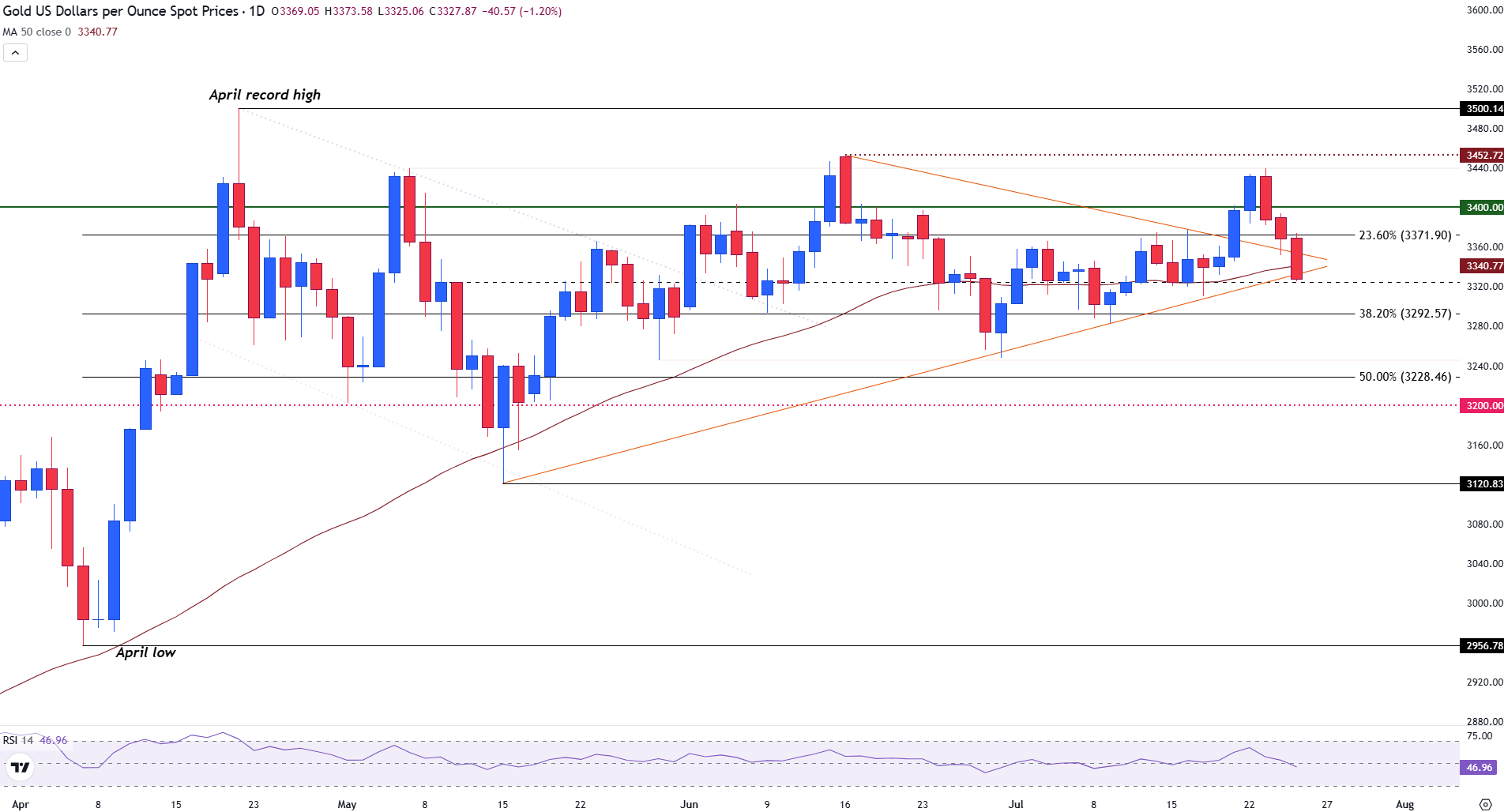- Gold slips below $3,350 as rising US yields and a stronger US Dollar pressure prices.
- Hopes for progress in US–China and EU–US trade talks lift risk appetite, reducing demand for Bullion..
- XAU/USD threatens triangle support as sellers pressure prices below $3,350.
Gold is trading lower on Friday as risk appetite improves, trade tensions ease, and the US Dollar firms.
At the time of writing, XAU/USD is trading below $3,330, down over 1% on the day, pressured by rising US Treasury yields and fading demand for safe-haven assets.
Friday’s US Durable Goods Orders report showed a 9.3% decline in June, better than the 10.8% drop expected but still a sharp reversal from May’s 16.5% surge.
The data, which tracks new orders for long-lasting manufactured goods like vehicles and machinery, is a key proxy for business investment and broader economic momentum. While the headline print was less negative than forecast, the underlying weakness reinforced concerns about slowing growth.
However, with risk appetite improving, equity markets stable, and traders focused on upcoming central bank decisions and trade negotiations, the softer data failed to meaningfully shift sentiment or revive safe-haven demand for Gold.
Gold remains sensitive to trade talks as risk sentiment shifts
The easing of global trade tensions has been a central driver of this week’s pullback in Gold. US President Donald Trump has signaled that countries offering greater access to US markets could receive preferential tariff treatment, citing the recently concluded Japan trade agreement as a model for ongoing negotiations with the European Union.
Under the proposed deal, most EU goods would face a 15% baseline tariff, a notable reduction from the 30% rate scheduled to take effect on August 1 if no agreement is reached.
Attention is also turning to next week’s high-stakes US–China trade talks. Treasury Secretary Scott Bessent will meet Chinese Vice Premier He Lifeng in Stockholm between Sunday and Tuesday to discuss extending the current tariff truce, which is set to expire on August 12.
Under the current agreement, tariffs on US imports of Chinese goods are subject to a 55% total tariff rate, while Chinese imports of US goods face a levy of 10%. The 55% tariff rate consists of a 10% baseline tariff, a 20% “fentanyl” tariff, and a 25% Section 301 tariff. The upcoming meetings in Stockholm will focus on potentially extending this truce and addressing other economic issues.
Should talks collapse, tariff rates would revert to 145% on Chinese imports and 125% on US exports, a development that could trigger a sharp deterioration in risk sentiment and reignite safe-haven demand for Gold.
Meanwhile, Chinese Commerce Minister Wang Wentao has expressed support for improving trade ties with the US, noting the mutual interest in restoring long-term economic stability. His comments helped ease market fears earlier in the week, reinforcing the broader risk-on environment.
Gold daily digest market movers: US employment data and Fed expectations keep pressure on Bullion
- On Thursday, US Initial Jobless Claims fell to 217,000, marking a sixth consecutive weekly decline and the lowest level since April. The report reinforced the strength of the US labor market and reduced pressure on the Fed to act quickly on rate cuts.
- A resilient jobs backdrop supports higher yields and the US Dollar, putting pressure on non-yielding assets, such as Gold.
- According to the CME FedWatch Tool, markets are now pricing in a 62.3% probability of a 25-basis-point rate cut in September, while the likelihood of no change stands at 36.1%. Although at least one rate cut remains priced in this year, recent Fed commentary suggests growing caution.
- The Minutes of the June Federal Open Market Committee (FOMC) meeting revealed that most officials were hesitant to ease monetary policy, citing inflation risks driven by higher import costs, especially in the context of unresolved trade disputes.
- This makes the outcome of ongoing US-EU and US-China trade negotiations particularly important. A failure to reach new agreements could reintroduce tariff-related price pressure and complicate the Fed’s policy path. In such a scenario, investors could return to Gold as a hedge against renewed market volatility and inflation.
Gold technical analysis: XAU/USD threatens triangle support, bringing $3,300 into focus
Gold is under pressure on Friday, as the price threatens to break below a key ascending triangle support on the daily chart.
After failing to hold above the psychological $3,400 level earlier this week, the metal is now trading near $3,327, signaling a potential shift in short-term momentum. The breach of both the triangle pattern and the 50-day Simple Moving Average (SMA) around $3,340 reinforces a bearish technical bias.
Sellers appear to be gaining control following the rejection from the recent swing high at $3,452. Immediate support lies at the 38.2% Fibonacci retracement level near $3,292, followed by the 50% retracement at $3,228. A sustained move below these levels could expose deeper downside toward the $3,200 zone. Meanwhile, RSI has slipped below 50, reflecting fading bullish momentum.
Momentum has also weakened, with the Relative Strength Index (RSI) hovering just below neutral at 47, signaling growing downside risk if buyers fail to defend the current support zone.

Gold daily chart
Despite the recent breakdown, the broader uptrend remains intact unless key support levels are taken out. For bulls, the immediate goal would be to reclaim the $3,340 level (50-day SMA) and push back above $3,400, which has acted as both psychological and structural resistance.
A daily close above that zone would invalidate the bearish breakout and shift focus back toward $3,452—the recent high. A breakout beyond $3,452 would confirm bullish continuation, opening the door for a retest of the all-time high near $3,500.
Tariffs FAQs
Tariffs are customs duties levied on certain merchandise imports or a category of products. Tariffs are designed to help local producers and manufacturers be more competitive in the market by providing a price advantage over similar goods that can be imported. Tariffs are widely used as tools of protectionism, along with trade barriers and import quotas.
Although tariffs and taxes both generate government revenue to fund public goods and services, they have several distinctions. Tariffs are prepaid at the port of entry, while taxes are paid at the time of purchase. Taxes are imposed on individual taxpayers and businesses, while tariffs are paid by importers.
There are two schools of thought among economists regarding the usage of tariffs. While some argue that tariffs are necessary to protect domestic industries and address trade imbalances, others see them as a harmful tool that could potentially drive prices higher over the long term and lead to a damaging trade war by encouraging tit-for-tat tariffs.
During the run-up to the presidential election in November 2024, Donald Trump made it clear that he intends to use tariffs to support the US economy and American producers. In 2024, Mexico, China and Canada accounted for 42% of total US imports. In this period, Mexico stood out as the top exporter with $466.6 billion, according to the US Census Bureau. Hence, Trump wants to focus on these three nations when imposing tariffs. He also plans to use the revenue generated through tariffs to lower personal income taxes.

